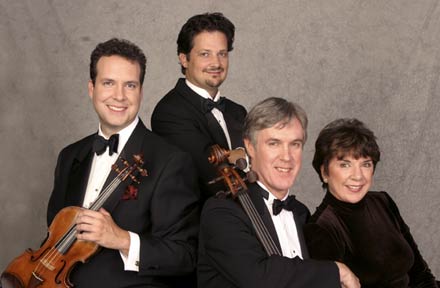A double helping of string quartets at Festival Miami

Bergonzi String Quartet
A large audience filled Gusman Concert Hall Sunday night for a chamber music program at Festival Miami featuring the Bergonzi String Quartet and the debut of the Stamps String Quartet, a student ensemble.
The Bergonzi players, all veteran faculty members of the Frost School of Music, repeated the Debussy quartet and Bartok’s first string quartet from their Mainly Mozart Festival program last May and offered three ingenious arrangements by Scott Flavin, the group’s sturdy second violin.
Under a new academic program, the Stamps foursome, all freshman students at the University of Miami, are being mentored by the Bergonzi and members of the Cleveland Orchestra (during the latter’s annual Miami residency) for four years and will have numerous performance opportunities.
The recently formed group opened the concert with the Allegro from Haydn’s Quartet in D minor, Op.76, No.2. Already they display crisp, nearly flawless articulation and invigorating enthusiasm that comes across vividly in performance. First violinist Arianne Urban, a native Miamian and graduate of the New World School of the Arts, is a strong, incisive leader who excelled in solo lines marked by singing tone and precision. At this point. the players seem less aware of the subtleties beneath Haydn’s gleaming surface. They offered a once-over-lightly reading, giving less than due weight to the storm clouds of the subtext. Greater artistic insight will, no doubt, come as they continue their studies and perfect their ensemble.
Bartok’s six string quartets are high watermarks in twentieth century chamber music and worthy successors to the late quartets of Beethoven for sheer originality, thematic invention and contrapuntal complexity. On this occasion, the Bergonzi ratcheted up the intensity level, delving into the angst ridden Lento with searing passion. The players seem to thrive on Bartok’s technically daunting instrumental writing. Ross Harbaugh’s virtuosic cello solos were brilliantly delineated. In the Allegro vivace finale, the players pulled out all the stops in a wild Hungarian dance pulsating with throbbing rhythmic energy.
Debussy’s masterful Quartet, Op.10 received a refreshingly straightforward reading, the players stressing linear clarity and surging rhythm over perfumed sheen. This was the chamber music equivalent of Pierre Boulez’s freshly scrubbed, clearly sculpted performances of Debussy’s orchestral scores. With artifice removed, the score’s modernity stood in bold relief. The bright, plucked strings and riveting viola solo (by Pamela McConnell) of the second movement churned with fierce momentum. Glenn Basham’s violin rode the spare melodic pulse of the third movement, stressing the music’s antique roots reinvented in modern tonal colors. A harddriving performance of the final movement rose to a fierce crescendo of impressionistic color and light. The players’ lean, compact sonority yielded dividends, clarifying Debussy’s misty harmonic palette and bracing cyclorama of dissonance in multi hued patterns.
Between the two quartets, Flavin’s engaging transcriptions offered a dose of salon elegance. Flavin stated that William Primrose’s arrangement for violin and piano of Arthur Benjamin’s Jamaican Rumba (originally prepared for Jascha Heifetz) was the source for his expanded quartet version. With Basham adding a touch of Fritz Kreisler schmaltz to the featured violin part, the performance exuded ebullient charm . Allegre by the late Cuban composer and former Miamian Rene Touzet, was an amiable vignette, old fashioned in the best sense of the term. Flavin’s imaginative version of Schubert’s Erlkonig evoked terror and sadness. Very different from the vocal original, this arrangement painted the music in Lisztian terms with vital dramatic heft.
Posted in Performances
Leave a Comment
Mon Oct 18, 2010
at 2:16 pm
No Comments